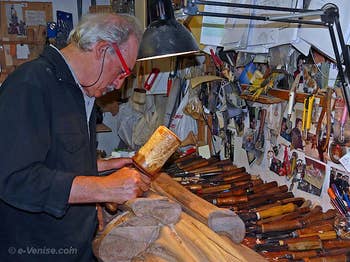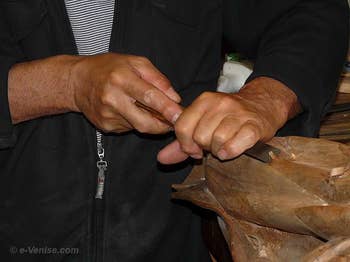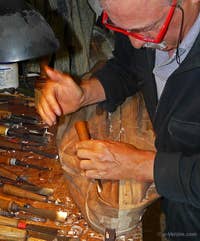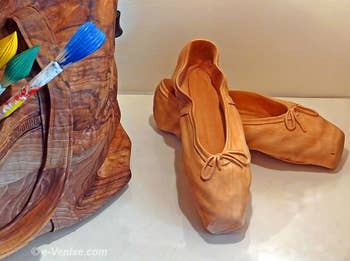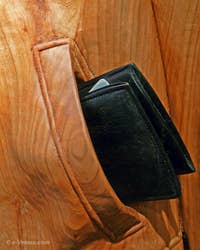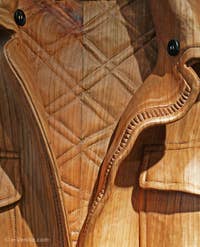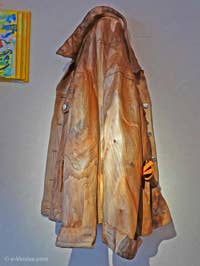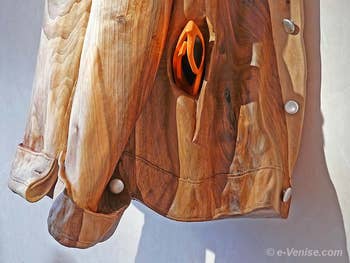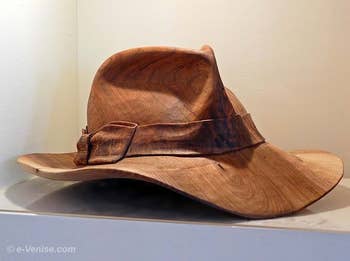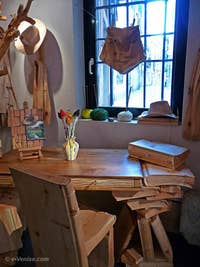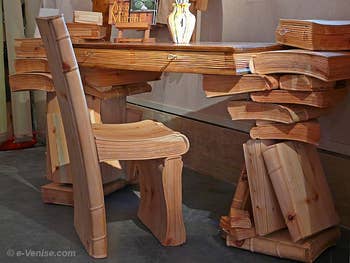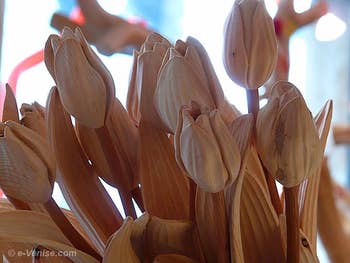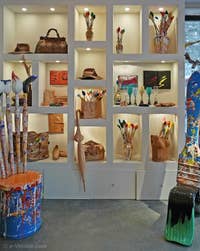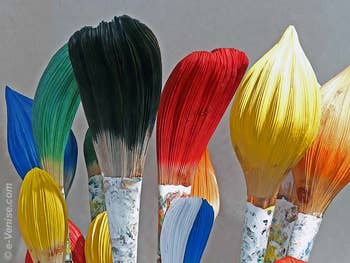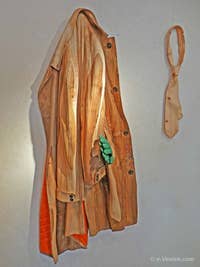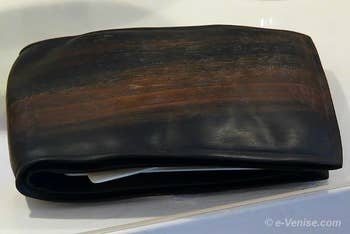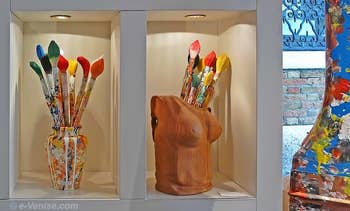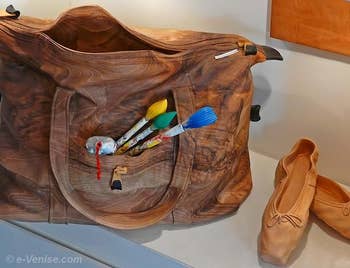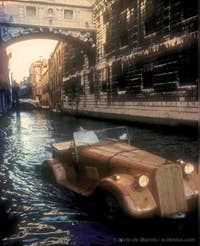Shopping Food Drink | Fashion | Carnival | Books | Glass Beads Jewels | Art Objects | Useful
Art Objects Mirrors | Model Boats | Bronzes | Forcole | Antiques | Wood Sculpture | Marbled Papers
Livio de Marchi in Venice, Venetian woodcarver
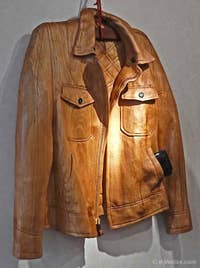
Carved jacket Being a woodcarver in Venice means being part of a centuries-old tradition, continuing the work of Venetian masters who left us beautiful sculptures in Venetian churches, or even those who, like Francesco Pianta the Younger in the 17th century, combined talent and humour and left us beautiful sculptures, some of which can be seen in the Scuola San Rocco.
And it is precisely in the Scuola Grande San Rocco that, executed by Francesco Pianta the Younger, a deceptively real library carved entirely out of wood, including the books.
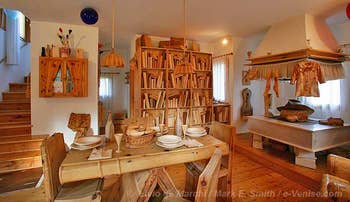
The House of Books Inspired by this Venetian master, Livio de Marchi also created numerous book sculptures and even a “House of Books”, a house with a floor area of six by six metres and two storeys, whose outer walls are made of carved books.
In addition, of course, the entire interior of the house, from the small spoons to the bread in the basket and the fruit on the table to the furniture, is made entirely of wood.
Livio de Marchi was born in Venice, where he began his training at a young age with the Venetian master sculptor Vittorio Biasotto.
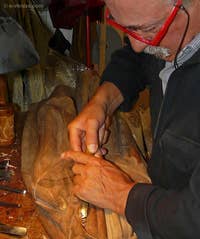
Livio de Marchi During his training with Biasotto, Livio also attended drawing and art courses at the Accademia di Belle Arti” in Venice.
His talent quickly became apparent, as he was already able to work with other materials such as marble and bronze as well as wood at a young age.
As a result, Livio opened his first studio and shop at the age of eighteen, where he exhibited his works, and then moved to Salizada San Samuele in 1965, where he is still based today.
Although his work is in the centuries-old continuity of his Venetian masters, it is also the work of its time, a work that had to be publicised beyond the borders in order to exist and make a name for itself.

Volkswagen Beetle Canal Grande Livio began with sculptures “Events”, for example by carving car models in original size: a Ferrari F50, a Jaguar 1937, a Fiat Topolino Model A, a Mercedes or even a Volkswagen Beetle.
And as Livio de Marchi is first and foremost a Venetian, his cars don't drive, they sail!!!
In front of the Doge's Palace, under the Rialto Bridge or even under the Bridge of Sighs, in short, in all the most prestigious and famous places in Venice, Livio sails his amphibious vehicles to the delight of tourists and journalists alike.
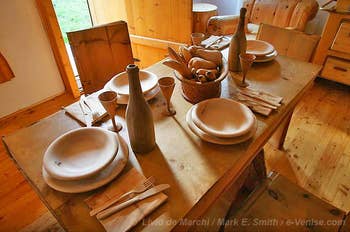
The House of Books Livio quickly became world-famous and has exhibited all over the world since the 1980s, including in the USA: Tokyo, Düsseldorf, Zurich, Munich, Amsterdam, Chicago, Palm Springs, Paris, etc.
His first “bookshop” in Tambre d'Alpago (BL) was also a great success, further strengthening his worldwide reputation.
This was followed by a second bookshop in Germany and a third bookshop in Japan.
And if that wasn't enough, Livio also carved a pumpkin carriage and carriage to drive along the Grand Canal in Venice.
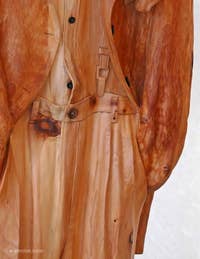
wood-carved costume In addition to these monumental works, Livio de Marchi has specialised in “realistic” works: Leather bags and garments that look as vivid as if they were made of leather and fabric, umbrellas that are as real as life, etc...
When you see Livio's work, the precision of the drawing, the volumes and the quality of the execution, you wonder if there really is anything he can't carve, so much does his skill shine through in everything his chisel touches.
Livio de Marchi uses various woods to create his works, such as Swiss stone pine, but also walnut, cherry, ebony, rosewood and boxwood.
When you see him working in his studio, you realise that his dexterity is not enough. Livio thinks as much as he works, he pauses, feels, looks, picks up another chisel, another chisel, walks around his work...
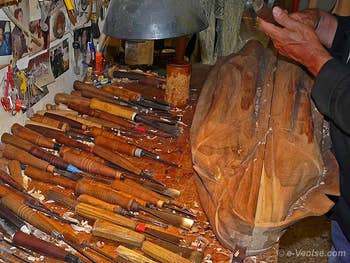
Livio in his studio You can tell that speed of execution is not his problem, that's not what he's looking for, he wants to do “good” and “beautiful” first, he takes his time, he gives himself pleasure first when he carves.
For Livio's satisfaction lies above all in creating something, in bringing these pieces of wood to life, in using their visible grain to give them even more life.
It is an osmosis between Livio and the material that you experience when you watch him at work.
He breathes, he inhales, he touches, he caresses ... to then carve even better, to make the precise and correct chisel stroke that gives the visible and tangible "more" that characterises his works.

umbrella and brush Incidentally, when we asked him how long it takes to carve one of his famous umbrellas, for example, his answer was
- I don't know, I don't count the time ...
Since we still wanted to have an idea, we insisted:
- A week, a month?
- Oh no, not a month, but yes, about a week.
An utterly Venetian answer! Because here everything is “circa”: approximately.
And you get the same answers for a Venetian recipe.
Here you will never be told 50 grams or 100 grams of this or that, but... “circa” by showing you the palms of their hands or spreading their fingers slightly to measure...
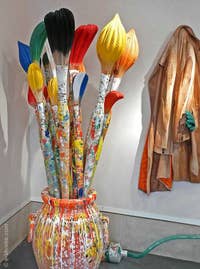
Carved wooden brushes Livio de Marchi measures the time in which his works are created in the same way: circa, but with the heart.
Because Livio has plenty of heart.
Aside from being an artist, he is in fact extremely kind, caring and simple.
At home, in his studio, he doesn't play the artist, even if his big hat and moustache have become famous.
It is a hospitable Venetian, a craftsman with the heart of an artist who welcomes you, and it is Venice that you feel in the palm of his hand when you say goodbye.
So if these few photos have whetted your appetite to see the works of Livio de Marchi, hurry to his gallery Salizada San Samuele, just a few steps away from Palazzo Grassi.
His works are exhibited there at prices ranging from €60 for a small carved book to several thousand euros for larger works.
Gallery Livio de Marchi
St Mark's no. 2742/A Calle del Dose Da Ponte, Corte Da Ponte - San Maurizio30124 - Venezia (Italia)
Phone: +39 041 528 56 94
Opening hours and days of the gallery
Monday to Friday: from 9:00 to 12:30 and from 13:30 to 17:00.Closed on Saturdays and Sundays.
The gallery is closed in August.
Art Objects Mirrors | Model Boats | Bronzes | Forcole | Antiques | Wood Sculpture | Marbled Papers
Shopping Food Drink | Fashion | Carnival | Books | Glass Beads Jewels | Art Objects | Useful
Back to Top of Page


